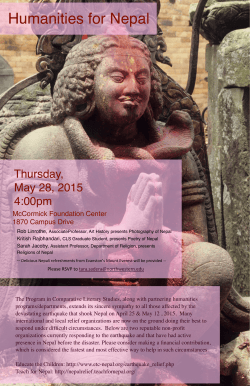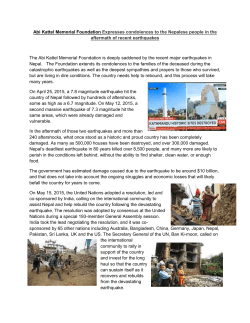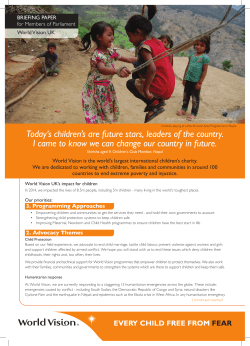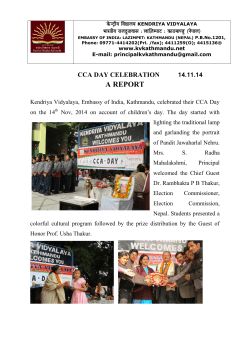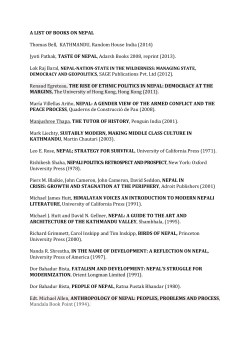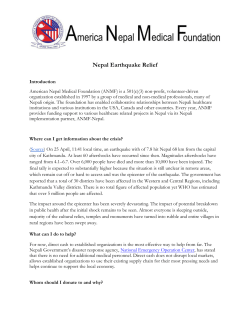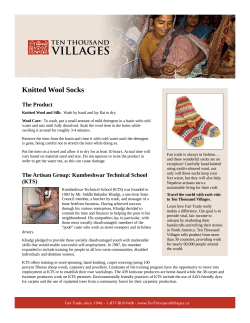
PARI: Strengthening Health Research in Nepal Kathmandu, 6th
Lecture Series LXXXIII PARI: Strengthening Health Research in Nepal Kathmandu, 6th April 2015 Prof. Edwin van Teijlingen Partnership on improving Access to Research Literature for Higher Education Institutions in Nepal (PARI) Grantholders: Ram Sharan Pathak, Padam Simkhada, Bhimsen Devkota, Edwin van Teijlingen Collaborators: Trilochan Pokharel, Pramod Regmi, Julie Bruce, Amudha Poobalan, Janet Ashwell, Brijesh Sathian, Paras K. Pokharel, Shyam Lohni, Sujan Marahatta, Dayaram Lamsal, Shishir Gokhale. References: Simkhada, P., van Teijlingen, E., Pokharel, T., Devkota, B., Pathak, R.S. (2013) Research Methods Coverage in Medical & Health Science Curricula in Nepal, Nepal J Epidemiol 3(3): 253-258. www.nepjol.info/index.php/NJE/article/view/9185 Simkhada, P., van Teijlingen, E., Devkota, B., Pathak, R.S., Sathian, B. (2014) Accessing research literature: A mixed-method study of academics in Higher Education Institutions in Nepal, Nepal J Epidemiol 4(4): 405-14. www.nepjol.info/index.php/NJE/article/view/11375 PARI: Evidence-based practice Evidence-based medicine or health care or policy-making relies on good information to base your decisions upon. ↓↓ Good research evidence needs to be collated, assessed and disseminated for practitioners / policy-makers. ↓↓ Best possible research evidence needs to ‘fit’ into local culture and available health systems & services. ↓↓ Research is about being critical & questioning! PARI: Research in Nepal HE (Higher Educ.) which is research-based or research focused seems to be in its infancy in Nepal, but growing. Teaching at Nepalese universities appeared to be more didactic than in the UK. What we teach doctors/nurses today as best practice “much of it will be out of date or wrong in 15 years time”. Health care workers need skills to find and assess available research evidence for their future practice. University staff needs right attitudes, skills & confidence to offer research-based teaching (=Capacity Building). Limited research capacity Conducted research to establish state of health & medical research in Nepal in period 1996 to 2007. Limited research capacity II Paper concluded: • number health research articles is small, perhaps due to: – lack of funding; – poor health research planning & policies; – lack proper training; – an underdeveloped research culture. Research capacity focus • Limited research capacity • Underdeveloped research culture • Practice needs to be evidence-based • Research resources (e.g. HINARI) people don’t know about it and/or use it • Motivated by MDG 8: Develop a Global Partnership for Development WHO: HINARI PARI: Overview Capacity-building programme to ensure higher education staff in Nepal become more aware of world-wide electronic literature and use this information critically. 2010 - Curricula review & Needs assessment - Training package development 2011 - Field testing training package - Training academics & librarians across Nepal 2012/2013 - Workshop Curriculum Improvement - Development of Network & Dissemination 2014 - Wring academic papers. PARI: Research Methods Mixed-Methods Approach: • Primary research: 1. Questionnaire study 200+ staff in universities. 2. Interviews with senior academics 3. Focus groups discussions with students • Secondary research: 1. Curriculum review MacKenzie Bryers, H., van Teijlingen, E., Pitchforth, E. (2014) Advocating mixed-methods approaches in health research, Nepal J Epidemiol 4(5): 417-422. PARI: Staff Survey 2010 Aims • To assess staff’s IT access, experience in research-teaching, publishing, using electronic data bases, etc. Methods • Questionnaire study of over 200 members of staff of many colleges of four universities. THANK YOU! THANK YOU! Simkhada P et al. (2014) Nepal J Epidemiol 4(4): 405-14 PARI: Staff Survey 2010 • Most respondents were female, had MSc, 1-5 years experience, quarter was <30 , nearly half aged 30-39. • Only 47.5% published in journal; men & higher ranks more likely than women/lower ranks. • Internet in nearly all institutions, all had library. • Few thought librarians supported accessing databases. • PubMed & HINARI only elect. databases mentioned. • Quarter institutions had some research capacity funding. Staff Survey: Staff access to electronic resources Simkhada P et al. (2014) Nepal J Epidemiol 4(4): 405-14 PARI: Qualitative Overview • Heads of department, coordinators and principals of institutions offering health-related degrees were interviewed about: importance of research, IT facilities, students’ motivation, skill /abilities staff in accessing research literature, curricula reviews, etc. • Four focus groups with students, each with 7 to 12 participants. One FGD each was held at four different institutions with students from various health-disciplines. PARI: Interviews • All agreed research-methods teaching is important • All claimed to have IT facilities, but: (a) not all computers were equally good; (b) not enough computers for all students; or (c) no generator. • Electronic data bases were not always used. • Generally positive about library staff’s IT ability. • Mixed responses about abilities of teachers on searching research literature. The notion was that younger staff was more familiar with IT in general • Need for training recognised, both not widely available. PARI: Student Focus Groups Students IT literate, had home computers, some without internet. Internet used more socially than for study. Computer labs open all day (6 AM to 6 PM) working days but these were not well managed. Students used PubMed, HINARI, BMJ, NEJM, WHO Bull., open-access journals, search engines (Google). Lack of knowledge and experience in using of research literature among students and staff. Accessing research literature should be in curriculum Make accessing electronic data bases examinable to get students to study. Make it count. Summary Nepal health research Higher Educ. which is research-based or research focused seems to be in its infancy in Nepal, but growing. Teaching at Nepalese universities appears to be more didactic than in the UK. Health care workers need skills to find and assess available research evidence for their future practice. Younger (newer) staff generally more familiar with IT. University staff needs right attitudes, skills & confidence to offer research-based teaching (=Capacity Building). Curriculum Review Method THANK YOU! Simkhada P et al.(2013) Nepal J Epidemiol 3(3): 253-258. Example Matrix: Undergraduate BSc Nursing Name of Programme BSc Nursing Literature review Research design - qualitative/quantative Statistics Sampling Ethical consideration in research Writing up proposal Citation and referencing Systematic review/ meta analysis Data analysisData analysis software 1 2 3 4 GAPS Observations Curr. Review • As expected much more research related contents at Master's level than Bachelor • Content of research varies within the level • Research component Bachelor varies from as low as 1% to over 20% of total course • Some curricula are ‘new’, whereas others are more than a decade old • MD: least defined ‘research methods’ curricula Strengths • Basic statistics included in most curricula • Data analysis software • Newly introduced curricula have more detailed research component. • General health-related curricula have higher proportion of research related course • Access to electronic research literature database is mentioned in some curricula Gaps in most curricula • Weighting research-related elements varies among disciplines: Clin./ lab-based curricula are less defined. • Curricula vary within/between universities • Most curricula lack contents in – Ethical consideration in health research – Citation and referencing – Systematic review • Access elect. research literature can be improved Curriculum Review Simkhada P et al.(2013) Nepal J Epidemiol 3(3): 253-258. EBP workshop 2011 How to read a paper Three starter questions: • • • Why was the study done and what were authors testing? What type of study did they do? Was design appropriate to broad field of research in question? Parts of a paper A. Abstract B. Introduction/Background C. Methods D. Results E. Discussion F. References (Bibliography Find all key information Find aims & objectives Example slide from workshop material aimed at health staff on: ‘How to read a paper’ Workshops ‘outcomes’ • Concept and methodology of systematic reviewing was new to majority of Nepalese academics at workshops. • There is a need for hands-on training skills on critical appraisal and interpreting systematic reviews by health professionals. • One-day workshop in Kathmandu to bring as many directors of nursing & medical colleges together as possible to establish elements of EBP are most needed in health workforce. Workshop Dhulikal 2010 Workshop team at BP Koirala Institute of Health Science (BPKIHS) Overview PARI Dissemination • Each of the three years included dissemination workshop; • Dissemination through media; • Academic dissemination: – Conferences – Scientific papers – Webpages (less succesful) Media in English Media in Nepali Output Handbook for Research Methodology Freely available online at: http://paridelphe.edu.np/wpcontent/uploads/RM_Handbook_Fi nal_Press_09_Apr_2013.pdf Conferences • Bournemouth Univ. 2011 Global Vision Conference ‘International development through collaborative evidence-based practice workshops in Nepal: an example of Internationalisation.’ • Reading, UK 2012 BNAC conference: ‘Systematic review workshops on collaborative evidence-based practice for higher education institutions in Nepal’. • Poster 13th World Congress on Public Health (Ethiopia, 2012), ‘Improving Access to Health Research Literature for HE Institutions in Nepal’ https://wfpha.confex.com/wfpha/2012/webprogram/Paper9064.html Discussion points?? • Why do staff not know about resources such as HINARI? • Can we build capacity that is fit for purpose? The more we train Nepal’s health professionals the more employable they become in the West. THANK YOU!
© Copyright 2025


